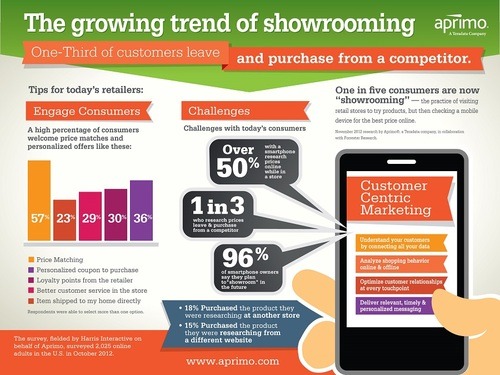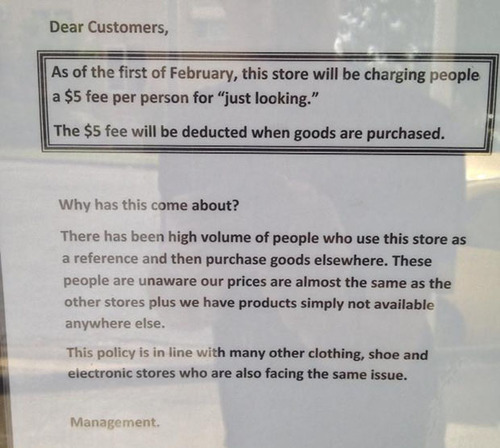Picture this consumer. She’s in your store and spots a shiny object on one of your shelves, only to gasp at the price then impulsively reach for her iPhone. You watch, horrified, as she pulls up Safari or Google or the Amazon app, and BAM, instantly finds a better deal. With a cocky flip of her hair, she breezes by the store staff unapologetic and empty-handed, knowing she can get (or already got) her new toy for less elsewhere. What just happened? She just committed “Showrooming”, the retail killer.
She used to comparison shop in-aisle, at point of purchase, with maybe an advertisement in mind or a flyer in hand to distract her. Then came the interwebs. Online shopping brought her a wealth of new options to buy from. Sure, it also brought delayed gratification, but why not if there are deals to be had? And if the goodies arrive only two days later, thanks to Amazon Prime?
An infographic from Aprimo about the growing trend of Showrooming
As Best Buy knows from store closures and reductions in footprint, showrooming is a serious threat and here to stay, with Wi-Fi and the proliferation of smartphones aiding and abetting consumer behavior. Some retailers have panicked in response. Target apparently stopped selling the Kindle, perceiving Amazon as a showrooming enabler, while others have actually penalized shoppers with a $5 surcharge for looking online.
A store in Australia attempting to do something about showrooming
Why prevent or punish showrooming when it represents a shift in consumer behavior? Consumers have every right to browse. Shopping is increasingly online and mobile, with smartphones merely driving the convergence of online with offline. As a recent mobile shopping study of nearly 2000 consumers revealed, 80% of respondents want more mobile-accessible product information when they’re shopping at retail, and over 73% have comparison shopped in-store using their smartphones.
Rather than run, retailers should embrace and integrate mobile into the shopping experience, recognizing the influence mobile can have leading right up to the point of purchase.
Don’t Fear Mobile, Marry it into the Mix
As Mobile Commerce Daily points out, marrying in-store and digital marketing efforts for a holistic approach is the way to succeed with modern consumers. Savvy retailers understand and accept mobile browsing, letting shoppers
- Opt-in to special in-store programs and prompts: triggering conversion using QR codes, SMS promotions, mobile coupons, social media campaigns, and links to videos
- Access their proprietary mobile apps: making it possible to easily look up products and pricing, and to answer questions when staff isn’t around
- Take advantage of better prices found online: expediting the purchase with a price-match guarantee, as painful as that may sound
These in-store, mobile activation instances extend the shopping experience within and beyond the store environment. They also enable savvy brands and retailers to capture data to better understand customer preferences, optimize staffing, and refine the shopping experience while building loyalty.
Adapt and Anticipate to Lead
The advent of mobile tactics in-store demonstrates a deeper understanding of consumer behavior. By extending its Low Price guarantee to match online retailers and opening up its store inventory data to the comparison shopping app RedLaser, Best Buy serves as an excellent example of a retailer tackling showrooming head on. Best Buy understands exactly what consumers want: the best possible options available, regardless of channel.
Companies that succeed don’t just follow but anticipate shifts in consumer behavior. They lead their industries by adapting to compete. Take House of Cards, original programming offered by Netflix for consumers to view at their own pace. As Forbes states, House of Cards represents the future of television with new and entrenched industry players all scrambling to develop their own programming and evolve their business models.
Get the Data to Win Her Back
Back to showrooming, a new norm to contend with at retail. The heightened competition offline and online means knowing what’s happening in these store environments across markets is more important than ever. Retailers and product manufacturers need intelligent and efficient ways to gather field data to inform their tactics.
An on-demand, mobile workforce like Gigwalk can help you truly understand what mobile means to the shopping experience, how others are redefining the multichannel customer conversation across locations, and what you can do to refine your programs to win. You can also use Gigwalk to test your mobile apps and trial usability with a subset of your target market.
The information you need is out there, to harness showrooming to your benefit. Don’t let your shoppers get away, whether they’re in store or not. Meet your consumers and hold that dialog wherever they browse. So that the next time a consumer starts browsing her iPhone instead of your shelves, a charming staffer or enticing promotion makes her promptly put it back in her pocket — or buy from your site instead of theirs.
Tanya Loh, Director of Customer and Business Development
Share this Post


